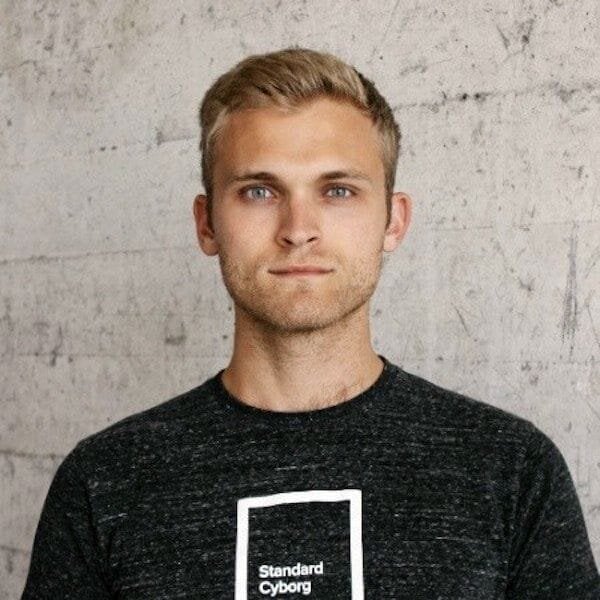![Jeff Huber, CEO of Standard Cyborg [Source: Jeff Huber]](https://fabbaloo.com/wp-content/uploads/2020/05/image-asset_img_5eb0901398984.jpg)
We had a chat with Jeff Huber, CEO of Standard Cyborg.
They are a startup company working in the 3D scanning space, which is leveraging the increasing presence of 3D scanning hardware found in modern smartphones. I first encountered them when reviewing the free “Capture” smartphone app for performing casual 3D scans. Since then we’ve managed to obtain the special mirror clip designed by Standard Cyborg to allow far more easier use of the Capture app; we can scan virtually any moderately sized object with ease now.
Fabbaloo: How and when did the company start? What was the trigger that caused the system to be developed?
Jeff Huber: “Standard Cyborg went through YCombinator in 2015 and has raised $3M. Our work has been featured in many publications, TechCrunch, Fast Company, Cnet, Fortune, Quartz, Business Insider, and many online publications. Garrett and Jeff, the cofounders, both received Forbes 30 under 30. Standard Cyborg has developed leading-edge vision and geometry tools.
For the past year, our team has been heads-down, focused on making an entirely new set of edge SDK and cloud tools for computer vision.
Our key insight was this: The tools for developers and teams to capture, analyze, and collaborate on computer vision data, 2D and 3D, were totally broken — complex, disparate, license-restrictive dependencies, arcane file formats, and a complete lack of cloud tools.
Our aim has always been to multiply the potential of the real world. And we realized that this contribution: making computer vision accessible to all, was the largest lever we could pull.”
Fabbaloo: What type of products does Standard Cyborg produce, and for whom?
Jeff Huber: “Standard Cyborg makes tools for computer vision. We offer both a mobile SDK for 3D scanning, classical processing, and machine learning, as well as a cloud backend for processing and team collaboration.”
Fabbaloo: Can you provide some examples of industries where these products could be used? What could the benefits be? Why are your clients using the system?
Jeff Huber: “The list of industries is too long to list here, really any industry that interacts with the real world in some way. Many of our current customers are using our tools for consumer product fitting and customization whether for glasses, shoes, helmets, rings, and more. These solutions are massively impacting real business metrics and we are so excited to support these companies in their missions.”
Fabbaloo: What type of hardware is required to perform this type of 3D scanning? How does the 3D scanning work?
Jeff Huber: “Our current production SDK works with TrueDepth, the camera that powers FaceID. Any device with FaceID (200 million+ and counting) will work. The 3D scanning technology is called structured light which works by projection 30,000 infrared dots at 30 frames-a-second and then reads those dots using a infrared camera. The same technology is used in Structure Sensor as well as the first generation Xbox Kinect.”
![Using Standard Cyborg’s Capture 3D scanning app [Source: Fabbaloo]](https://fabbaloo.com/wp-content/uploads/2020/05/image-asset_img_5eb09013dc0f1.jpg)
Fabbaloo: Are 3D scans obtained with your system directly 3D printable? What has to be done to make them so if not?
Jeff Huber: “For something to be 3D printable, it must be a watertight mesh. Capture currently outputs a point cloud. A mesh has vertices and faces, a point cloud has only vertices. There are a number of great free tools that make it quite easy to do the conversion process.”
Fabbaloo: With this hardware and your system, what kind of 3D scanning is possible? What is not possible?
Jeff Huber: “The sensor is range-limited at the physics/hardware level. We recommend people scan up close (within 3 feet/1 meter) for great resolution, and so for that reason it’s generally easy to scan small to medium sized objects.”
Fabbaloo: Is there a cloud-based component to the system? How does it work? What is processed locally?
Jeff Huber: “All scan processing happens locally on your phone. People can use Capture without an account. For added, still free, functionality like easy link-sharing and downloading in common 3D file formats — users can create an account and sync their data to their personal secure cloud account.”
Fabbaloo: How do you expect handheld 3D scanning hardware on smartphones to evolve in the future? What would that mean for your system?
Jeff Huber: “There will be a Cambrian explosion in phones, sensors, and use cases over the next couple years. Android devices already have world-facing time-of-flight in some handsets and this trend will continue. In very short order, 2-3 years, 3D scanning will be completely democratized and I think we will be amazed at how people use these new superpowers in their pockets. We’re excited to be a part of that market and meaningfully accelerate it.”
Fabbaloo: What specific products do you offer, and what is the pricing levels? Or pricing method?
Jeff Huber: “Our consumer app, Capture, is 100% free, including no-ads, and always will be. Businesses and organizations use our SDK and cloud tools to build 3D sensing into their own apps and use cases and we charge for that service.”
Fabbaloo: Is there a way to test your 3D scanning system before committing to a purchase?
Jeff Huber: “Capture is free for consumers to use, and our SDK is free for developers to use for 500 scans.”
Fabbaloo: Where do you expect Standard Cyborg to go next? What products or improvements are you working on in the lab, if you can give us some hints?
Jeff Huber: “We are excited to multiply the potential of the real world by making computer vision accessible to all. We have a ton up our sleeves! In short, we want to make it easier to capture, analyze, and collaborate on 2D and 3D computer vision data.”
Huber adds that anyone interested in Standard Cyborg’s products, including Capture, can contact him at jeff@standardcyborg.com.
Via Standard Cyborg

